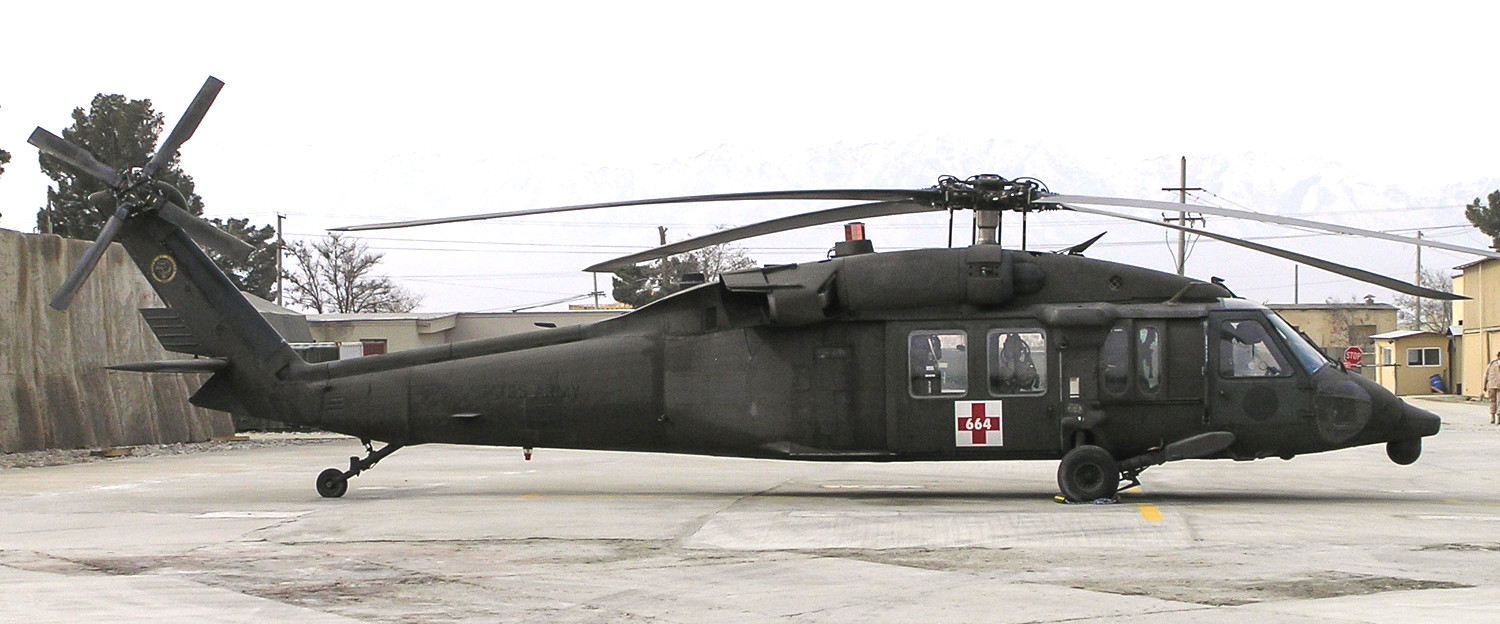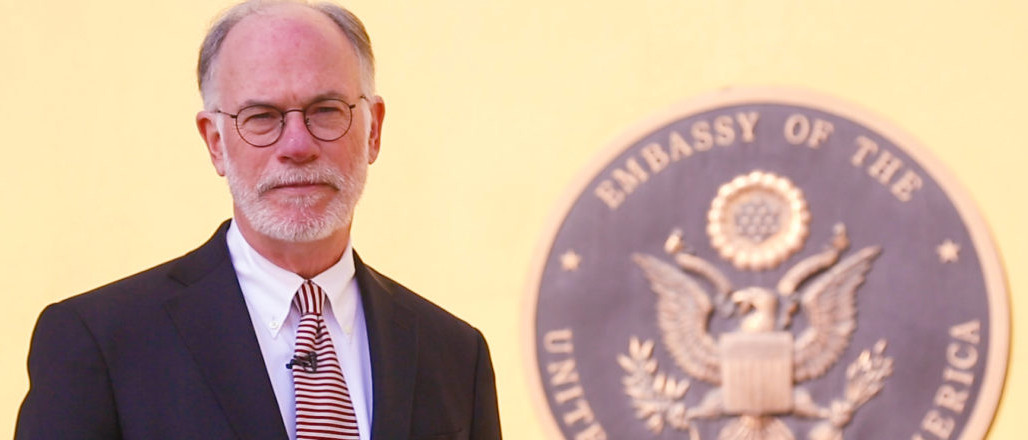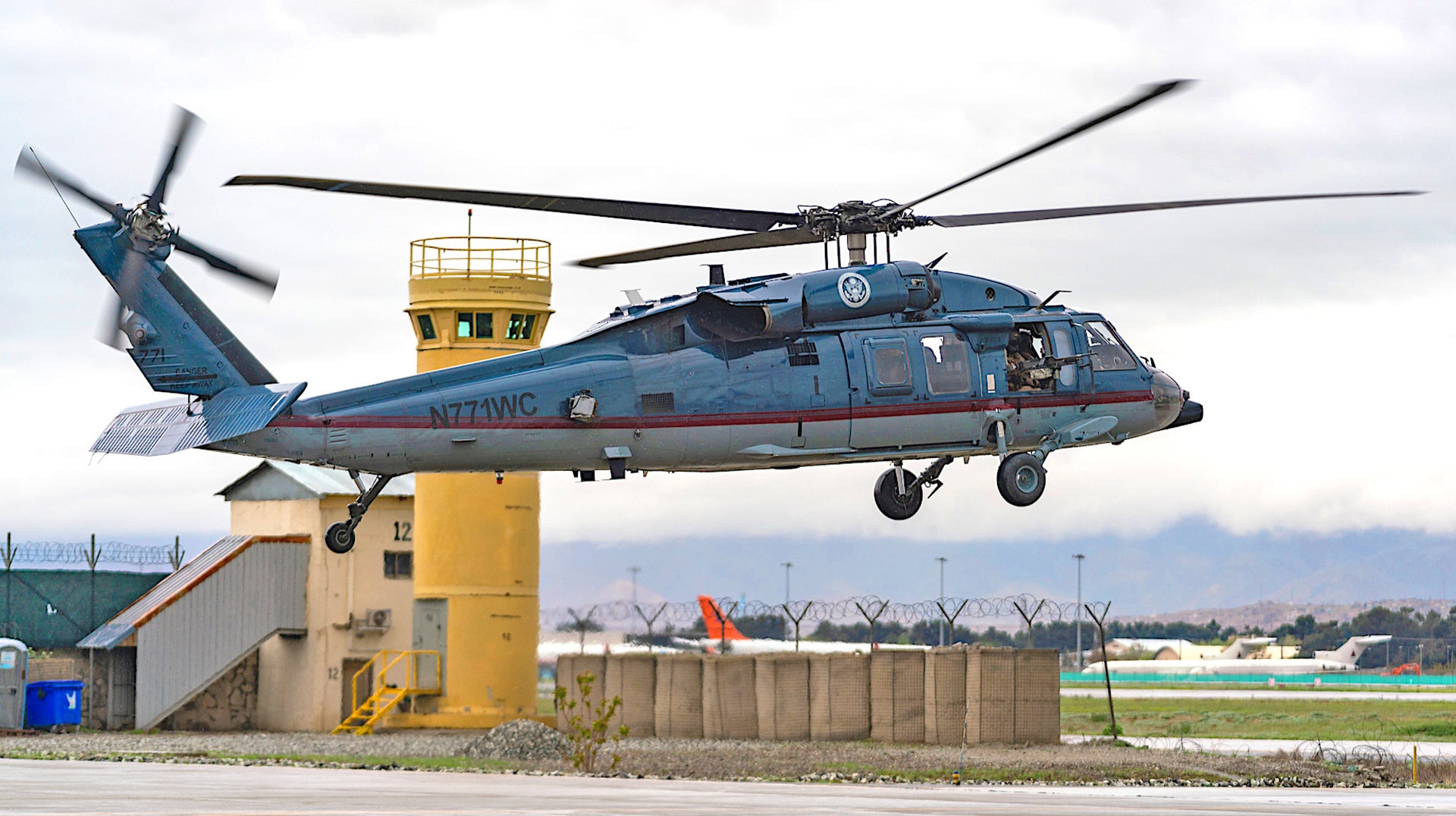Some of the newest additions to the U.S. Department of State’s Air Wing, ex-U.S. Army Black Hawk helicopters of various types, are now flying in Afghanistan. Though the department has been conducting a variety of aviation operations there for more than a decade now, the Black Hawks provide support to the U.S. Embassy in Kabul. This is a mission that could be even more important in the coming weeks and months as the withdrawal of American military forces from the country continues to move ahead at a brisk pace and if the security situation continues to deteriorate.
The presence of the State Department Black Hawks in Afghanistan, which are painted in a distinctive blue-over-gray paint scheme with a red cheatline along the center of the fuselage, was highlighted back in April when U.S. Secretary of State Antony Blinken traveled to the country. At least three of these helicopters, with the U.S. civil registration codes N35WN, N36LN, and N771WC, all of which are HH-60L variants, helped shuttle Blinken, members of his entourage, and other officials around Kabul during that visit.

In Army service, the HH-60Ls, which have been steadily replaced by newer HH-60Ms, were primarily configured for casualty evacuation missions. They are readily distinguishable from standard UH-60 utility variants by the duckbill-like sponsons on their noses. A sensor turret with electro-optical and infrared cameras can be installed underneath, though the available pictures and video of State Department examples do not show them with any such systems fitted.

The State Department HH-60Ls, which are used primarily as personnel transports, have a variety of antennas on top and below their fuselages not found on their Army counterparts, suggesting they have received a more robust communications package. This would make good sense, especially for the ones in Afghanistan, which, as already noted, can find themselves moving around senior officials, including the Secretary of State.
At least some of these State Department Black Hawks, which are all contractor-operated, have 7.62mm M240 machine guns mounted in the crew chief windows on either side of the helicopter. They also have launchers for decoy flares on the tail boom.
It’s not clear when the first State Department Black Hawks arrived in Afghanistan, but it appears to have occurred sometime in the last year or so. The Air Wing, formally known as the Bureau of International Narcotics and Law Enforcement Affairs’ Office of Aviation, or INL/A, had begun acquiring these helicopters by 2018, as you can read more about in this past War Zone feature. It presently has nine of them, all HH-60Ls, according to the Federal Aviation Administration (FAA).
However, during a visit in March 2020, then-Secretary of State Mike Pompeo rode in ex-U.S. Marine Corps CH-46 Sea Knight helicopters, which had been the primary State Department helicopter in use in the country for years at that point. It’s also unclear whether any of the CH-46s, or any other Air Wing helicopters, also remain in use in Afghanistan now that the Black Hawks have arrived.

For years now, primarily for security reasons, Air Wing helicopters have been the default means of getting between Hamid Karzai International Airport in Kabul and the U.S. Embassy, despite the distance between the two only being around two miles. This operation is known as Embassy Air and a similar arrangement also exists in Iraq. The extremely short State Department helicopter rides in Afghanistan have been relatively pricey, with the individual round-trip “ticket” cost to the U.S. government for these brief jaunts reportedly rising to $2,250 in 2019. As a result, Embassy Air has been somewhat controversial in the past, as you can read about more here.

Any past controversies notwithstanding, the Air Wing’s Black Hawks in Afghanistan, and any other helicopters it operates there, could become very significant assets in the near future. After almost two decades of operations in the country, the U.S. military is on pace to meet President Joe Biden’s deadline of having withdrawn almost entirely by September, a pullout that has already been moving ahead very quickly and that may well be complete as soon as August.
Other members of the NATO-led coalition in the country are also steadily withdrawing. Just today, U.S. officials announced that there were no more American or other foreign military personnel at Bagram Airfield, a large base in Afghanistan Parwan Province just north of Kabul that had long served as one of the coalition’s major operational hubs.

Pentagon Press Secretary John Kirby also revealed at a briefing today that Secretary of Defense Lloyd Austin had approved a plan to shift command authority for operations in Afghanistan from U.S. Army General Scott Miller, the current head of U.S. Forces-Afghanistan and the NATO Resolute Support Mission, to U.S. Marine Corps General Frank McKenzie, head of U.S. Central Command (CENTCOM). This transfer of authority to a much higher-level officer outside of the country, which is set to take place this month, is a clear reflection on the dwindling size of the U.S. military’s presence in Afghanistan. The main office in charge of U.S. military security cooperation with the Afghan government will also move to Qatar. A smaller U.S. Forces-Afghanistan (Forward) command element will subsequently be established in Kabul.
What the exact U.S. military force posture will look like in the end is unclear, with reports suggesting that up to 1,000 personnel could remain to perform various missions. These could include advising and liaising with Afghan security forces and providing security for any remaining American facilities in the country, such as the Embassy. In April, CNN had reported that the U.S. military was actually deploying a 650-person contingency force, primarily drawn from the U.S. Army’s 75th Ranger Regiment, an elite special operations unit, to bolster security amid the ongoing withdrawal.
Whatever that precense is “will remain focused on four things over the course of the coming period. One, protecting our diplomatic presence in the country,” Press Secretary Kirby said at his briefing today. “Two, supporting security requirements at Hamid Karzai International Airport. Three, continued advice and assistance to Afghan National Defense and Security Forces as appropriate. And four, supporting our counterterrorism efforts.”
What other U.S. forces, such as Central Intelligence Agency (CIA) paramilitary personnel and specialized units from the State Department, to include elements of the Air Wing, will remain is also still unclear. The Embassy in Kabul itself has been operating at a reduced level since April, when non-essential staff made an “ordered departure” from the country. Approximately 4,000 personnel, including Afghan nationals and private contractors, in addition to diplomatic staff, continue to work there, according to Politico. It’s also worth noting that the United States does not presently have a formal ambassador to Afghanistan, with chargé d’affaires Ross Wilson presently running the Embassy.

Politico
had also reported today about potential events that could force the U.S. Embassy to further reduce its staff or shut down entirely based on a list of unclassified “decision points” from a three-year-old version of an Emergency Action Plan that the outlet obtained. These points, which include more mundane triggers, such as acts of terrorism or violent protests, would not all automatically lead to dramatic action. However, some of them, including the outbreak of a pandemic, a major factor facing anyone working there now, are clearly more serious than others.
The “anticipated long-term or actual disruption of utilities, fuel, water, goods, and services (including means of communications), which eliminates [the embassy’s] ability to maintain safe and healthy conditions for staff” would certainly prompt major discussions about the viability of continued operations at the Embassy, as would if “the security situation in Afghanistan deteriorates such that security forces in Kabul are diminished or otherwise unavailable, weakening the host government’s ability to respond to … requests for security support.”
When it comes to the Air Wing’s mission, another one of the decision points has to do with whether or not there is “ground and/or air access” to Hamid Karzai International Airport or if “commercial flights become limited or stopped.” Separately, U.S. and NATO officials have been negotiating with Turkish authorities about having that country’s forces continue to help secure Hamid Karzai International Airport after all the other withdrawals are complete.
As it stands now, there are already significant concerns about the ability of the government in Kabul to continue providing security across the country, with the Taliban having made significant territorial gains in recent weeks. That militant group, the chief opponent to Afghanistan’s current central government, has also seized hundreds of vehicles, as well as other weapons, ammunition, and other equipment, from Afghan security forces, who, in some cases, have turned that materiel over directly in exchange for safe passage out of certain areas.

“A civil war is certainly a path that can be visualized if this continues on the trajectory it’s on right now, that should be of concern to the world,” General Miller said earlier this week.
“We are looking very carefully at the security on the ground in Afghanistan and we’re also looking very hard at whether the Taliban is, at all, serious about a peaceful resolution of the conflict,” Secretary of State Blinken said at a separate press conference last week.
These security concerns are not limited to Afghanistan’s countrysides, either. The Associated Press reported that a local Afghan official had claimed that there had been little to no coordination regarding the transfer of Bagram to the country’s central authorities and that looters had quickly gained access before government forces could secure the base. Kabul itself has long been at risk of insurgent and terrorist attacks. In 2017, the U.S. military had announced plans to expand the boundaries of the highly secure “green zone” area in the city, in which the U.S. Embassy, other foreign diplomatic missions, and major government facilities are situated, over concerns about Afghan authorities ability to police adjacent areas.
The U.S. Intelligence Community has also reportedly assessed that the Afghan government could collapse within six months of the end of the U.S. military withdrawal. That, in turn, has prompted many to make comparisons to the fall of Saigon in 1975, which spelled the end of South Vietnam as a state and produced iconic, if embarrassing imagery of the scramble by Americans and others to flee the country.
This includes the famous image of a mob of people attempting to reach a Bell Huey helicopter belonging to CIA front company Air America sitting on a helipad on top of the CIA’s annex in Saigon. At the very end, there was similar pictures and video of U.S. military helicopters evacuating the nearby Embassy as part of Operation Frequent Wind.

A fear now, of course, might be that similar scenes involving the State Department’s Black Hawks could soon emerge from Afghanistan. Of course, even if the country’s central government persists for a protracted period of time after the end of the planned pullout of U.S. troops from the country wraps up in the next few months, Air Wing helicopters are likely to become an even more important means of getting U.S. personnel safely around Kabul.
Contact the author: joe@thedrive.com

